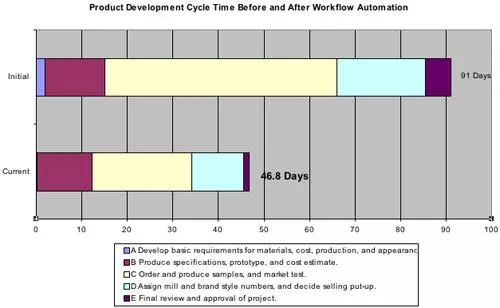May 2002
Situation ...
A company designs and manufactures high quality apparel for a variety of customers. Over many years, the product development cycle gradually evolved in an ad hoc fashion.
Problem ...
While this client's customers praised the quality of the product, these same customers told the company that their competitors were creating new products more quickly than the client. The current product development process:
- Proved time-consuming and cumbersome.
- Required multiple forms containing repeated or unused data.
- Moved information among departments and multiple locations using paper forms delivered by inter-office mail.
- Provided only paper documents for current and historical reference.
- Permitted no visibility of the current status of projects.
- Obscured responsibility for process tasks.

Solution ...
We worked with our client in two ways:
- Reviewing the business process to determine bottlenecks, identify problem areas, and outline a new process with revised forms.
- Designing and developing an automated workflow application to implement the revised business process.
Features of the automated workflow include:
- Electronic mail provides users with notices of new tasks and of tasks that are past due.
- Project concepts are created and managed at a high level by Marketing and Design managers, while project work orders are generated at a detail level for the Product Development, Accounting, and other staff.
- Centralized electronic database houses current and historical product development data and knitting specifications, making this information accessible quickly and easily.
- Quick views of the current status of all product development projects aid the management of multiple, concurrent projects.
- Information and images in this application automatically populate the Mill Specifications, Product Images, and Knitting Programs applications, eliminating a variety of manual tasks.

Results & Benefits ...
- Process cycle time was cut by 50%.
- Data entry time was reduced by at least 25%.
- Rework caused by incomplete or inaccurate information was virtually eliminated through enforced data validation.
- Detailed statistics for the completion time of each step in the process provide the basis for further improvements targeting another 15% reduction in cycle time.
- Approximately 2,000 hours of annual work was permanently removed from the process.
Conclusion ...
The client used the automated workflow-enabled product development process to improve, standardize, and shorten the product development process. We continue to work with this client to further streamline and automate related processes, further reducing cycle time.
For More Information ...
To discuss how technology usage and business process improvements could be applied to the issues facing your business, call us at 336.297.4200 to schedule a no-obligation consultation, or click here to contact us online.





